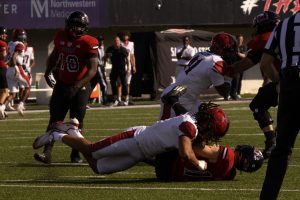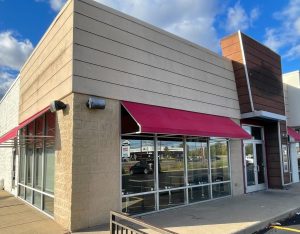Volunteers integral to theater
September 13, 1990
Claudia Pitts is a self-described “popcorn-making monster.”
Don’t worry, she’s not dangerous until she’s behind the counter at the historic Egyptian Theater, 135 N. Second St.
Pitts, a graduate psychology student at NIU, is one of about 100 volunteers at the theater. She decided to volunteer while touring the theater three years ago and has been creating popcorn havoc twice a month ever since.
Although Pitts prefers working the concessions stand, like most volunteers she does a little bit of everything. “You’re not stuck doing one thing over and over,” she said.
Pitts also enjoys volunteering time at the theater for the social outlet it provides. “It’s hard to meet people other than students when you’re a student. This has given me a chance to meet other people.”
Pitts is also helping to preserve the Egyptian Theater’s history.
The Egyptian was built during the onset of the Depression. Its doors were open for the first time on Dec. 10, 1929 and the first film shown on the theater’s giant screen was “The Hottentot,” a film about horse racing. General admission was 50 cents for adults and 25 cents for children.
The theater continued as a commercial venture for almost 50 years. Aside from providing years of movies and live shows, the theater once hosted John F. Kennedy, who gave a speech from its stage during his race for the presidency.
In November, 1977, the doors of the Egyptian closed after years of neglect. The theater, now a National Historic Site and one of six remaining Egyptian-style movie palaces in the world, came dangerously close to being demolished in 1978 in favor of a parking lot.
A public meeting was called and Preservation of the Egyptian Theater (PET) was formed in March 1978. Through various fundraisers and contributions the theater was saved from the wrecking ball and was purchased by PET in 1980 for $100,000.
However, the years of neglect had taken their toll on the building. In 1982, the state provided $2,125,000 from horse racing revenues for restorations which took place between July 1982 and July 1983.
During the restoration, high-tech stage lighting was installed, and improvements were made to the sound system, dressing rooms and ventilation system.
The most significant aspect of the restoration was the recreation/restoration of the ten wall murals in the auditorium. The murals give the effect of walking through an Egyptian courtyard, with scenes of the Temple of Rameses II, Abu Simbel, the Stepped Pyramid at Sakkara, the Pyramids of Gizeh as well as the Collosi of “Memnon,” Thebes.
Golden seated pharoahs are positioned on either side of the stage and “stars” twinkle in the azure ceiling.
Chicago architect Elmer Behrens and his assistant had used depictions of the pharoah Rameses II throughout the building. Terre-cotta pharoahs gaze from the facade of the building, sharing the space with the 18-foot stained glass window showing the Egyptian sacred scarab holding the sun aloft while standing on the earth.
In the main lobby are lotus flowers and buds in the cornices with falcon wings and the sun god Ra on the walls near the ceiling, flanked with sacred serpents.
Auditorium doors and other doors include windows which follow the arch design first used in the facade shape. The exit lights feature falcon wings.
However, the ‘82-’83 restoration didn’t solve all the theater’s problems caused by time and the elements. Current restoration to the terra-cotta on the top third of the front facade of the building is being funded by $115,000 of funds from the City of DeKalb. The terra-cotta is 60 years old and is falling off, PET President Barbara Kummerfeldt said.
Pieces of the terra-cotta are being taken off and replaced with exact duplicates made of polymer. The restoration should be done by the end of October, Kummerfeldt said.
The theater’s architecture is only part of its uniqueness – what other theater in DeKalb would show “Longtime Campanion” or “Henry V?”
Films are picked by Kummerfeldt and another volunteer for their quality and critical acclaim. “We feel that we serve this area in a special fashion,” filling the gap left by other theaters showing strictly mainsteam movies, Kummerfeldt said.
The theater, now managed by PET and owned by DeKalb County Exposition Authority, is self-sufficient and doesn’t get any tax money for its operating budget. Its funding comes instead from ticket sales, rentals to groups and from individual and private donors.
Volunteers like Claudia Pitts play an integral part of running the theater, Kummerfeldt said. They do everything from balancing the books to cleaning up the theater after shows. Kummerfeldt, a projectionist and a part-time cleaning person have the only paid positions at the theater.
Volunteers must work at least 30 hours a year. About four are needed for movies and as many as 16 for a live event.
Where would the historic Egyptian Theater be without its “popcorn-making monsters” and other valuable volunteers?






